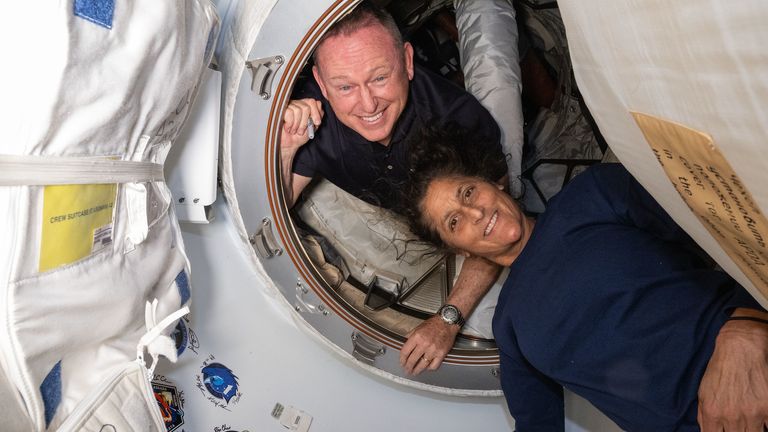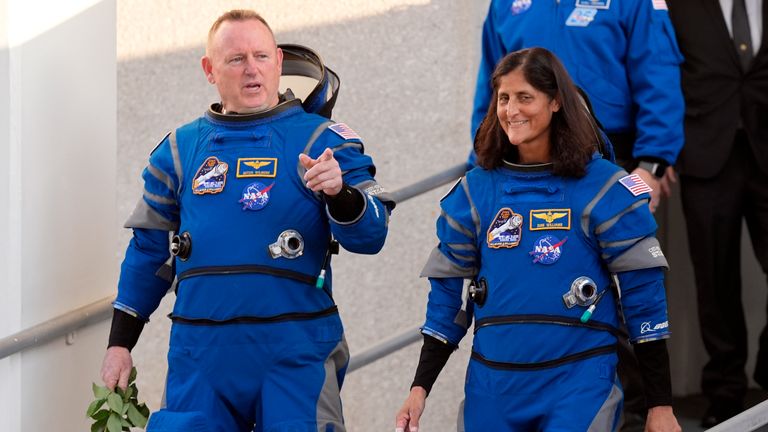It is the plot of numerous science fiction films: two astronauts are stranded in space and do not yet know how to get back.
Sunita “Suni” Williams and Commander Barry “Butch” Wilmore reached the International Space Station (ISS) in June as the first crew to test Boeing’s new Starliner, which experienced helium leaks and engine failures before docking – raising questions about its safety for the return flight.
Boeing has insisted that the astronauts are not stranded and that there is “no increased risk” in bringing them back in the Starliner, but NASA is considering bringing them back on a SpaceX flight instead.
They were only supposed to be in space for eight days, but now they are there for more than two months and may have to stay until February.
But is the supply sufficient for such a mission, how are they doing psychologically and what does everyday life on the ISS look like?
Size and features
The ISS is 356 feet (109 m) long from end to end, just over the total length of an American football field, including the end zones.
According to NASA, the living and working space is larger than a six-bedroom house and has six bedrooms, two bathrooms, a gym and a bay window with a 360-degree view.
As you will see later, it is not quite as luxurious as it sounds.
Ms Williams and Mr Wilmore are not alone; they share the facilities with seven other astronauts from other missions; four of them are Americans and three are Russians.
Is there enough food, water and oxygen?
Yes, there are reserve supplies up there that will be available to the astronauts for a long time.
The space station has its own oxygen production systems and about 50% of the oxygen exhaled from carbon dioxide is recovered.
As for water, the station has a recycling system to convert urine into drinking water. Part of this system also captures the moisture released into the cabin air by the crew’s breath and sweat.
The food supply is a little more sophisticated. Meals are prepared at NASA’s Space Food Systems Laboratory in Houston, where chefs take care to ensure that the food is both appetizing and nutritious.
Much of it is dehydrated, which means it needs to be filled with water before consumption, while some is already ready and just needs to be heated.
The station kitchen offers meat (e.g. grilled beef brisket), eggs, vegetables, bread, savory snacks and sweet treats.
In addition, the crew members can also request their personal favorite pieces from the shelf.
In a video on NASA’s YouTube channel, Ms. Williams revealed that her favorite product is Nutter Butter spread – and showed a jar that her family had sent her.
When were deliveries last sent?
The space probe regularly receives further supplies from Earth, the last one arriving on August 6.
The shipments, launched on May 30 by rocket from Kazakhstan, included about three tons of food, fuel and other supplies for Ms. Williams, Mr. Wilmore and the seven other crew members on board.
In principle, the crew can place their orders for the items transported on these spacecraft in discussions with mission control before launch.
That was good news for Mr Wilmore and Ms Williams, who were forced to leave their personal luggage behind to make room for extra equipment before their departure in June. That meant they had to wear spare clothing that was already on the ISS when they arrived.
Her own garments finally arrived with the August 6 deliveries, and more deliveries are expected to follow in a few months.
Once the supply ships at the ISS are emptied, the crew fills them with their garbage before sending them back to Earth.
How to use a gravity toilet?
Some things just don’t appear in space movies – but on NASA’s YouTube channel, Ms. Williams delves into the dirtier details of life in space.
In the video filmed in 2012, Ms Williams showed the toilet, which is somewhat reminiscent of a toilet you might see on an airplane.
Read more:
Barracks to house space radar to protect Britain
How injecting “glitter” into Mars’ atmosphere could make it more habitable
The difference is that there are two separate tubes – one for urine and one for feces. The urine tube, which is colored yellow, is attached to the wall and looks almost like a vacuum cleaner – and fittingly, it has a suction function to prevent gravity from making a mess.
The hose for the big business looks more like a normal toilet, also with a seat – but you have to hold on to a handle on the wall next to it so that you don’t float away when you go to the toilet.
The good news is that there are about half a dozen types of toilet paper stuffed in bags on the toilet walls, including wet wipes and disinfectant wipes in case “something goes wrong,” as Ms. Williams puts it.
Astronauts are also each given a toiletry kit containing things like a toothbrush and toothpaste (which must either be swallowed or spit into a tissue) and a hairbrush – which Ms Williams said is useless in space because gravity keeps hair constantly standing upright.
What about sleeping arrangements?
Remarkably, you can sleep on the floor, on the wall or on the ceiling.
Because without gravity, the crew never feels like they are lying down. Whether they are lying on the ground, standing or hanging upside down – everything feels the same.
For example, there are sleeping stations on the ISS the size of telephone booths that the crew lives in and which consist of a sleeping bag and a pillow on the floor, on the wall and on the ceiling.
Leisure time
When not conducting space experiments, the crew can enjoy views of Earth from the station’s observatory deck or head to the Advanced Resistive Exercise Device (ARED) in the Tranquility node—a fancy term for a piece of fitness equipment.
ARED offers traditional upper and lower body exercises such as squats, deadlifts, heel raises, bicep curls and bench presses through the use of vacuum cylinders that replicate the weights found in gyms.
The crew is advised to use it throughout their stay in space, as muscle and bone atrophy are common during long missions.
How are they both doing?
They are both retired Navy captains and long-time NASA astronauts who have completed long space station missions.
Before the test flight, Mr Wilmore, 61, and Ms Williams, 58, said they expected to learn a lot about the Starliner and how it works.
At their only press conference from space in July, they assured reporters that they remained busy helping with repairs and research, and expressed confidence in all the Starliner tests taking place behind the scenes.
“I have a good feeling that the spacecraft will bring us home without any problems,” Ms. Williams told reporters.
Tests are currently taking place on Earth to determine whether the Boeing spacecraft can still be used safely for the return transport.
“You know the mantra: ‘Failure is not an option.’ That’s why we’re staying here now,” Wilmore said last month.
“We trust that the tests we are doing are the ones we need to do to get the right answers and get the data we need to come back.”
They have not yet commented publicly on the prospects of an eight-month stay.
Deanna, Mr Wilmore’s wife, told AP earlier this week that he was “pleased” with his arrival at the space station and was “neither worried nor anxious.”
She said Mr Widmore, a longtime elder at a church in Texas, trusts that God is in control and that this brings his family “great peace”.
What happens now?
Currently, all but one of the Starliner’s five failed engines have been reactivated in orbit.
Tests are currently underway on Earth to fix the problems encountered in space, but engineers aren’t sure exactly what’s causing them. In addition, they’re trying to plug helium leaks in the Starliner’s propulsion system, which is critical for maneuvering.
Boeing has reiterated that its capsule can still bring astronauts home safely, but the company will need to modify the Starliner’s software in case a crewless return is necessary.
Ken Bowersox, NASA’s space mission director, said it was still possible to return home on the same plane.
Mr Bowersox said at a recent meeting that they had “heard from a lot of people who had concerns and the decision was not clear”.
The SpaceX flight they would take instead would leave Earth in September, but two of the designated astronauts would have to stay home to make room for Ms. Williams and Mr. Wilmore.
A decision is expected around next week.
Would this be the longest time anyone has spent in space?
No – Russian Valeri Polyakov set this record in the mid-1990s when he spent 437 days outside of Earth.
And last year NASA astronaut Frank Rubio returned from a 371-day journey along with Russian astronauts Sergei Prokopyev and Dmitri Petelin, breaking the record for the longest time spent in space by an American.
This trip, like today’s, was extended due to technical problems and was originally supposed to last only six months.









